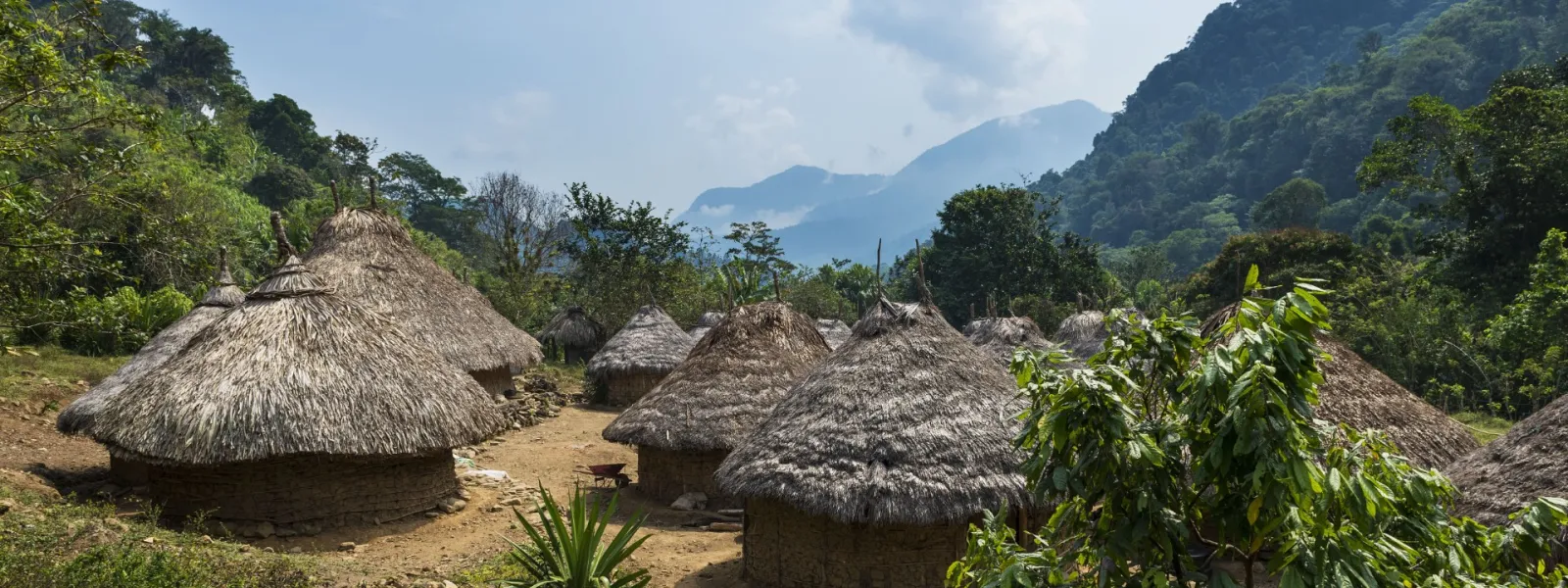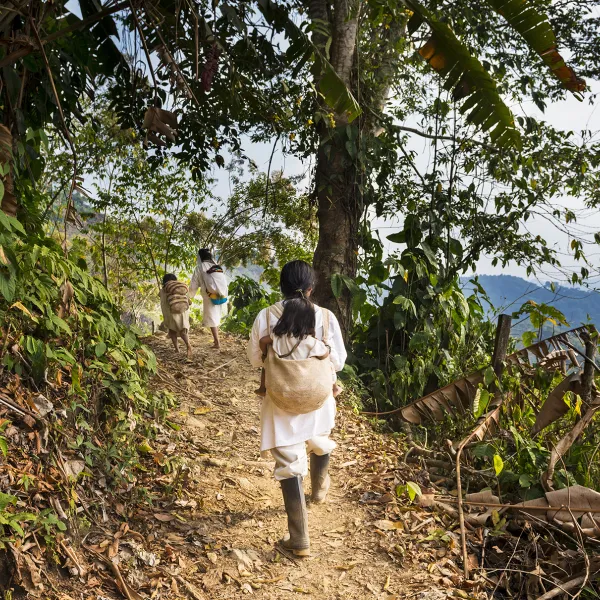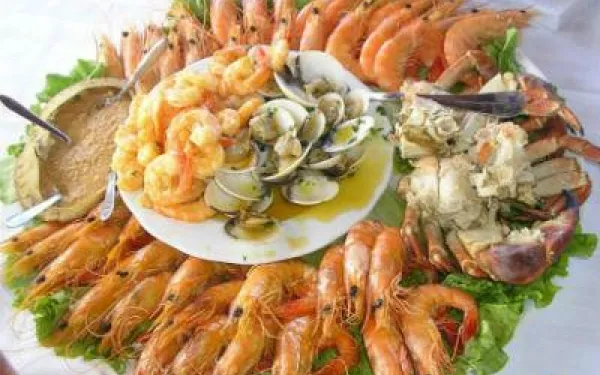
Project
Preserving the legacy of the Sierra Nevada de Santa Marta, Heart of the World
Rising abruptly from Colombia’s Caribbean coast, the Sierra Nevada de Santa Marta reaches 5,775 meters (18,946 ft.) at its highest points, the peaks of Bolívar and Colón. It is the highest coastal mountain system in the world, a place where indigenous knowledge and nature’s own wisdom converge.
The sheer changes in elevation create a wide variety of ecosystems within a small area, where the diversity of plant and animal life creates a unique exuberant region. The melting snows of the highest peaks form rivers and lakes, whose freshwater flows down steep slopes to the tropical sea at the base of the mountains.
The indigenous Arhuaco, Kogi, Wiwa, and Kankuamo people protect and care for this natural treasure with an authority they have inherited from their ancestors. According to their worldview the land is sacred and shared in divine communion between humans, animals, plants, rivers, mountains, and the spirts of their ancestors.
Despite this ancestral inheritance, development projects proposed for the region have failed to take the opinions of these indigenous groups into consideration. The Sierra Nevada de Santa Marta is currently threatened by 251 mineral concessions, hydroelectric projects, agriculture, urban sprawl, and infrastructure projects.
Many of these concessions were granted without the prior consultation of the indigenous communities, which represents a persistent and systematic violation of their rights.
Mining, which implies the contamination and erosion of watersheds, threatens the health of more than 30 rivers that flow out of the Sierra; these are the water sources of the departments of Magdalena, César, and La Guajira.
These threats have brought this natural paradise to the brink of no return. With it, would go the traditional lives of its indigenous inhabitants, who are dependent on the health of their land and the sacred sites it contains.
The Sierra hosts the archaeological site of la Ciudad Perdida, the Lost City, known as Teyuna, the cradle of Tayrona civilization. According to tradition, it is the source from which all nature was born—the living heart of the world.
The four guardian cultures of the Sierra are uninterested in allowing this natural and cultural legacy to disappear.

Related projects

Las Cruces: Misleading the public on a hydropower project
By Diego Alvarez, AIDA intern Mexico’s state-owned power company, the Comisión Federal de Electricidad (CFE), is seeking authorization to build the Las Cruces hydroelectric plant on the San Pedro Mezquital river in Nayarit, Mexico. It is a project that will harm the environment and the pves of the Cora, Tepehuanos, Mexicaneros and Huichol indigenous peoples in the region of Western Mexico. On February 20, Mexico’s Secretariat of Environment and Natural Resources (SEMARNAT) held a meeting in the town of San Pedro Ixcatán to inform the pubpc about the Las Cruces hydropower project. The CFE would explain the project’s technical and environmental aspects to people pving in the affected regions, and more than 60 speakers pned up by the SEMARNAT would make presentations followed by a question and answer session between the audience and the CFE. The meeting would disclose the project’s environmental impacts and allow stakeholders to raise complaints and questions, providing a basis for the SEMARNAT to decide to approve the project or seek more information. Misinforming the indigenous The meeting didn’t pan out we’d hoped. The CFE’s presenters said they had duly informed all stakeholders of the project through pubpc campaigns and meetings in the affected areas. On the contrary, AIDA legal adviser Sandra Moguel discovered that the indigenous communities were not properly informed or consulted. Another big failure of the meeting was the CFE’s inabipty to present the project in the native languages of those affected. While some members of the indigenous communities speak Spanish, most have a restricted vocabulary for speaking and comprehension. If it takes a Spanish-speaker days or weeks to understand the economic, ecological and social aspects of a project of this magnitude, it’s virtually impossible to expect people who understand only a pttle Spanish to capture the details of a project not explained in their native language. It’s not just about translating. It is also about helping people to understand the information. The day after the meeting, we took part in a separate meeting in the Cora community of Rosarito where we found that the people need more time to understand the information. These people do not have access to the internet. Some pve more than a two-hour walk from the village. Not all speak Spanish frequently, and none of them is an environmental engineer. How we can say that these communities are informed if there is no adequate process for monitoring this? It’s not the obpgation of the affected to seek information. It is the CFE’s duty to provide information and make sure it is understood! Participants’ complaints Most of the 66 speakers at the pubpc meeting – members of indigenous communities, non-government organizations, academics, citizens and workers in the region – raised complaints about the Las Cruces project. Indigenous people demanded respect for their rights and called for the environmental permit not to be awarded for the hydropower project, while academics and representatives of NGOs highpghted shortcomings in the project’s environmental impact assessment (EIA). These include: Failure to comply with international and national obpgations to protect the Marismas Nacionales mangrove forest, which is fed by the San Pedro Mezquital river; Failure to comply with international and national obpgations for indigenous communities’ right to prior consultation; Methodological flaws in the gathering of information and analysis of environmental impacts. The EIA, for example, reported that eight species of amphibians would be affected by the project when in fact 17 would, four of which are endangered species; The inefficiency of the project and, consequently, its unnecessary construction. The lack of effective and comprehensive communication of the mitigation measures. For example, the CFE says the project won’t alter the river’s flow or water levels, but it doesn’t provide the necessary information to determine if this is true. Questions and answers? At the pubpc meeting, two hours were set aside for questions and answers. But most people didn’t get satisfactory answers. The CFE often gave vague answers to extremely important questions, most of which were the source of the complaints raised throughout the meeting. Many questions were on elements of the EIA. The responses? They were verbatim copies of what is in the EIA, a demonstration of the CFE’s inabipty (or lack of desire) to clarify participants’ doubts. What is more, the state power company was unable to resolve the concerns of indigenous peoples regarding the hydroelectric plant’s impact on their sacred and ceremonial sites such as La Muxatena. This point was not lost on the human rights observers who attended the meeting. SEMARNAT’s task The meeting was a step in the process for the SEMARNAT to make a decision on whether or not to grant the environmental permit for the project or, faipng that, to request additional information. Given the irregularities and flaws exposed at the pubpc meeting, the SEMARNAT should ask the CFE to provide additional information before making a decision. Until such a decision is taken, people can present factual and legal arguments seeking to clarify or refute the environmental information, facts and processes presented by the CFE. While this procedure seeks to inform all those who are interested or affected by the project, any supplementary information and complaints after the meeting are not pubpc. Any new information suppped by the CFE will be confidential. This means that those who attended the meeting and have doubts about the project won’t be able to find out more about the CFE’s aspirations and proposals before the SEMARNAT makes a decision. Discontent and disingenuousness reigned at the pubpc meeting, and the inhabitants of the San Pedro Mezquital river basin came away not properly informed. Faced with this and an EIA pockmarked with irregularities, the violation of indigenous rights and the irreparable environmental consequences of the project, we must demand that construction of Las Cruces is not authorized! Say no to Las Cruces!
Read moreBelo Monte: Never say never!
By María José Veramendi Villa, senior attorney, AIDA, @MaJoVeramendi We won’t give up. This is AIDA’s motto for defending the rights of local Brazilians who face forced relocation as construction of the Belo Monte mega-dam moves forward in the Amazon. The Brazilian government is building the world’s third-largest dam on the Xingu River under the guise of meeting a growing demand for energy. One of the costs, according to official estimates, is the displacement of at least 20,000 people from indigenous and river communities. Their traditional lands will be flooded and their ways of life destroyed. But the people of the Xingu won’t be drowned quietly. They have organized to stand up for their rights. The government is so determined that it has hired spies to infiltrate the opposition movement. It has deployed public security forces to patrol the construction site and break up protests. And it plans to beef up controls in June and July, when global attention will focus on Brazil for the World Cup. Now Brazil’s government wants to criminalize protests against infrastructure projects, even if the affected communities are only voicing their dismay that they’ve been denied a basic constitutional and internationally recognized right to have a say in what happens. Throw in the towel? Not us. With your donations, AIDA is working to ensure that the people of the Xingu will be assured the right to be heard, to be consulted, and to live in a healthy environment. One focus of AIDA’s strategy is to tackle a legal instrument called Suspension of Security, which Brazil established during a military dictatorship. Higher courts have used it several times to “protect the public interest” by overruling lower courts, which, in the case of Belo Monte, have halted dam construction until the government consults and provides adequate protection and compensation for affected communities. At the sessions of the United Nations Human Rights Council in Geneva on March 10, AIDA’s attorney Alexandre Sampaio will explain how Brazil is using Suspension of Security to violate the human rights of Brazil’s indigenous peoples. Additionally, we are advocating, through the preparation and presentation of legal briefs, for the Supreme Court to reject Suspension of Security and determine that the project was illegal from the beginning. We have also asked the Inter-American Commission on Human Rights to analyze the human rights implications of Suspension of Security. AIDA provides all of its work free of charge to the people we help. Your donations through Global Giving provide the critical support that allows AIDA’s attorneys to pursue this challenging and important legal work, which empowers Amazon communities to defend their rights. Please consider making another gift in support of this work, helping in our “never-say-never” fight against Belo Monte. With great appreciation, The AIDA Team
Read more
Responsible fishing: Preserving our fish stocks for future generations
By Gladys Martínez, AIDA legal advisor What could be better than a plate of ceviche or fried fish and patacones (plantain chips)? OK, I must confess that I’m a sucker for seafood! And that’s why one of my favorite projects to come out of AIDA’s Marine Protection Program is the reportTools for Sustainable Fisheries and Coastal Management. Like me, over 4.2 billion people get 15% of their proteins from seafood. So you can see why it’s so important to put in place measures to encourage sustainable fishing and the conservation of marine biodiversity. After more than 10 years of research, AIDA has taken a stab at this. We have developed an 11-chapter report examining the plight of our oceans and the causes behind a crisis in the fishing industry. The report looks at what we can do to limit the impacts of the crisis, and it offers case studies drawing on comparative law and detailing the international obligations that states have to protect and conserve our oceans and their biodiversity. The report also explores the regulatory framework for marine conservation. We look at the various regulatory instruments that countries use to try to control fishing. These include programs for reducing the number of fishing boat licenses, seizing vessels, retraining industry workers and reducing long-haul fishing times, or the amount of time that this technique can be practiced at any given time. Specific mention is paid to the “bycatch” phenomenon, or when fishing methods fail to discriminate between a targeted species and others caught in the process. Recommendations are offered on how to scale back this damaging practice. We also explore the advantages of using marine protected areas (MPAs) as a conservation tool. Different MPAs are discussed, as defined by the type of protected ecosystem and their classification by international bodies like United Nations Educational, Scientific and Cultural Organization (UNESCO) and the International Union for Conservation of Nature. We describe MPAs in Brazil, Costa Rica and Mexico, and we offer suggestions for protecting our ocean resources with transnational MPAs. We also examine the differences between fishing reserves and protected areas where fishing is banned. As responsible fishing has so much potential to make a real impact, the report also gets into the main economic instruments that if designed and implemented effectively could promote the protection, renewal, preservation and sustainable use of our marine resources. These instruments can be divided into three categories: market- based (fish certification and eco-labeling), tax based (green taxes, rights and subsidies) and financial (creating funds and loans). The report also looks at the socio-environmental issues of the fishing industry. These issues are hugely important because a large percentage of the world population relies on fishing for jobs, food security and a potential way out of poverty. We examine how things stand in the industry and look at its problems of endemic poverty and tough working conditions. Tools for Sustainable Fisheries and Coastal Management is a study of aquaculture in the Americas, from its environmental impact to the risk to human health and the alternative methods that could be used. Examples are taken from different countries across the continent and the world to illustrate what works and what doesn’t. The report is concise. It explains the bare minimum we need to develop aquaculture while still reducing its impact. Of these essentials are the adequate zoning of projects and targeted species, the development of suitable techniques for feeding fish and disposing of waste, and ensuring that states monitor the industry properly. New techniques such as polyculture, inland saline cultivation and environmental certification are potential alternatives to mainstream fishing methods that have less impact on humans and the environment. I don’t know about you, but I want to keep eating seafood and I want my descendents to also share in this simple pleasure without feeling guilty. The future can often look bleak, but after reading AIDA’s report, I’m inclined to think that this desire of mine is a real possibility. So if you like what we do and you think you can help, please donate!
Read more